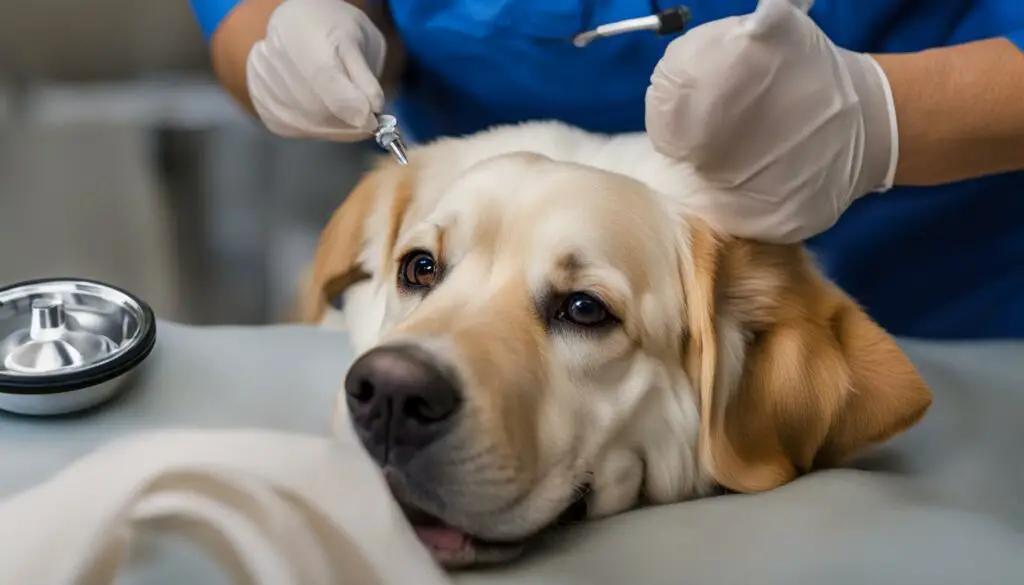Pyometra is a life-threatening infection that can affect unspayed female dogs. It is crucial to understand the timeline of this condition in order to provide timely intervention and potentially save a dog’s life.
Pyometra is a preventable infection that occurs in unspayed female dogs. It is caused by hormonal changes following a heat cycle, which can lead to the formation of cysts in the uterus and create an environment prone to bacterial infection.
The symptoms of pyometra can vary, but common signs include abnormal discharge, lethargy, loss of appetite, bloated abdomen, increased thirst, and vomiting or diarrhea. Prompt veterinary attention is necessary, as pyometra can progress rapidly and become life-threatening if left untreated.
The preferred treatment for pyometra is emergency surgery to remove the infected uterus. This surgery, known as an ovariohysterectomy or spay, is more complicated and expensive than a routine spay due to the need to contain the infection. Prostaglandins, medications that lower progesterone levels, may be an alternative treatment option, but they are less reliable and can have complications.
Key Takeaways:
- Pyometra is a life-threatening infection in unspayed female dogs.
- Early intervention is crucial for successful treatment.
- Pyometra is caused by hormonal changes following a heat cycle.
- Common symptoms include abnormal discharge, lethargy, loss of appetite, bloated abdomen, increased thirst, and vomiting or diarrhea.
- Emergency surgery to remove the infected uterus is the preferred treatment.
What Causes Pyometra in Dogs?
Pyometra is a serious uterine infection that commonly affects unspayed female dogs. It is caused by hormonal changes following a heat cycle, specifically a surge in progesterone. When a female dog goes through multiple heat cycles without getting pregnant, cysts can form in the uterus. These cysts create an environment that is prone to bacterial infection, leading to the development of pyometra.
While the exact cause of pyometra is not fully understood, hormonal imbalances play a significant role in its development. The surge in progesterone during the heat cycle triggers the thickening of the uterine lining, preparing it for potential pregnancy. If pregnancy does not occur, the lining continues to thicken, leading to the formation of cysts. These cysts create a breeding ground for bacteria, as the warm and moist environment promotes their growth.
It is important to note that pyometra can occur in any unspayed female dog, regardless of age or breed. However, older dogs are more prone to developing this condition due to repeated heat cycles and hormonal changes over time. Additionally, certain breeds, such as the Bernese Mountain Dog and the Rottweiler, have been found to have a higher predisposition to pyometra.
| Causes of Pyometra in Dogs | Summary |
|---|---|
| Hormonal changes following a heat cycle | Surge in progesterone leads to thickening of the uterine lining and the formation of cysts, creating an environment prone to infection. |
| Old age | Repeated heat cycles and hormonal changes over time increase the risk of developing pyometra. |
| Breed predisposition | Some dog breeds, such as Bernese Mountain Dogs and Rottweilers, are more prone to pyometra. |
Understanding the underlying causes of pyometra in dogs is crucial for early detection and prevention. By recognizing the risk factors and taking proactive measures, such as spaying your female dog, you can significantly reduce the chances of your beloved pet developing this life-threatening condition.
Symptoms of Pyometra in Dogs
Recognizing the symptoms of pyometra in dogs is crucial for early intervention and successful treatment. Here are the common signs to look out for:
- Abnormal discharge: The presence of pus or blood-like discharge from the vagina is a telltale sign of pyometra. It may have a foul odor and can range in color from white to greenish.
- Lethargy: Dogs with pyometra often appear tired and lack their usual energy. They may be less interested in activities and have increased periods of rest.
- Loss of appetite: Pyometra can cause a loss of appetite in dogs. They may show decreased interest in food or refuse to eat altogether.
- Increased thirst: Dogs with pyometra may drink more water than usual due to the infection affecting their overall hydration.
- Bloated abdomen: An enlarged or bloated abdomen can be a sign of pyometra. The uterus may become distended with pus or fluid, causing the abdomen to appear swollen.
- Vomiting and diarrhea: In some cases, dogs with pyometra may experience vomiting and diarrhea as a result of the infection.
If you notice any of these symptoms in your female dog, it is essential to seek veterinary attention immediately. Pyometra is a serious condition that can progress rapidly, and prompt treatment is necessary to ensure the best outcome for your canine companion.

Treating Cervical Pyometra vs. Closed Pyometra
It is important to note that the symptoms of pyometra can vary depending on whether the dog’s cervix is open or closed. In open pyometra, the cervix is dilated, allowing the pus and fluid to drain out of the uterus. This can result in visible discharge. In closed pyometra, the cervix is tightly closed, trapping the infection inside the uterus. Dogs with closed pyometra may show more severe symptoms, as there is no outlet for the pus and fluid.
Table: Comparison of Symptoms in Cervical Pyometra and Closed Pyometra
| Symptoms | Cervical Pyometra | Closed Pyometra |
|---|---|---|
| Abnormal discharge | Present | Absent or minimal |
| Bloated abdomen | Possible | More common |
| Overall severity | Less severe | More severe |
“Recognizing the early signs of pyometra and seeking immediate veterinary attention is crucial for a successful outcome.”
If you suspect that your dog may have pyometra, it is important to remember that early intervention is key. Prompt veterinary care can significantly improve the chances of a positive outcome and reduce the risk of complications. Don’t hesitate to reach out to your veterinarian if you observe any symptoms or have concerns about your dog’s health.
Treatment Options for Pyometra in Dogs
When it comes to treating pyometra in dogs, the preferred option is emergency surgery to remove the infected uterus. This procedure, known as an ovariohysterectomy or spay, is more complex and expensive than a routine spay due to the need to contain the infection. The surgery involves removing both the ovaries and the uterus, eliminating the source of the infection and preventing future occurrences. An ovariohysterectomy not only treats the current pyometra but also serves as a preventive measure against future uterine infections.
In some cases, prostaglandins may be used as an alternative treatment for pyometra. These medications work by reducing progesterone levels in the dog’s body, which can help to resolve the infection. However, it’s important to note that prostaglandins are less reliable than surgery and can come with their own set of complications. Your veterinarian will determine the most appropriate treatment option based on the severity of the infection and the overall health of your dog.
During the surgical procedure, the dog will be placed under general anesthesia. This ensures that they are comfortable and pain-free throughout the operation. It’s essential to discuss the risks and potential complications associated with surgery with your veterinarian beforehand. While the surgery itself carries some risks, such as infection or adverse reactions to anesthesia, prompt and proper medical care can minimize these risks and increase the chances of a successful outcome.
| Treatment Options | Advantages | Disadvantages |
|---|---|---|
| Surgical Removal (Ovariohysterectomy) |
|
|
| Prostaglandins |
|
|
It’s important to consult with your veterinarian to determine the best course of action for your dog. They will consider factors such as the overall health of your dog, the severity of the infection, and the potential risks and benefits of each treatment option. With prompt intervention and proper medical care, dogs with pyometra can have a good prognosis and go on to live healthy lives.
Risks and Complications of Pyometra
Pyometra in dogs can lead to serious risks and complications if left untreated. The infection can spread beyond the uterus, causing a condition known as septic abdomen or ruptured pyometra. This can be life-threatening and may result in the death of the dog. Prompt veterinary attention and treatment are crucial to prevent these complications.
Additionally, pyometra surgery itself carries some risks. There is a risk of infection at the surgical site, as well as adverse reactions to anesthesia. Your veterinarian will take precautions to minimize these risks, but it’s important to be aware of them.
Furthermore, there may be complications associated with the alternative treatment using prostaglandins. While this approach can lower progesterone levels and potentially resolve the infection, it is not as reliable as surgery and may have its own set of complications that need to be closely monitored.
“Prompt treatment is necessary to prevent complications and ensure the best outcome for your dog.” – Dr. Smith, Veterinarian
| Risks of Pyometra | Complications of Pyometra Treatment |
|---|---|
|
|
It is crucial to recognize the signs of pyometra in dogs and seek veterinary attention as soon as possible to minimize the risks and complications associated with this condition. Regular veterinary check-ups, spaying, and awareness of the symptoms can help prevent pyometra and ensure the overall health and well-being of your beloved canine companion.
Preventing Pyometra in Dogs
Preventing pyometra is essential for the health and well-being of your female dog. The most effective method of prevention is spaying, also known as neutering. By removing the uterus and ovaries, the risk of pyometra is eliminated entirely. Spaying not only prevents pyometra but also helps prevent other reproductive issues, such as mammary tumors and ovarian cancer.
Spaying your dog should be done at the appropriate age, as recommended by your veterinarian. Generally, it is recommended to spay dogs before their first heat cycle, which usually occurs around six months of age. However, consult with your veterinarian to determine the best timing for your dog.
While rare, there is a slight possibility of a condition called “stump pyometra” occurring after spaying. Stump pyometra is an infection that can develop in the remaining uterine stump. However, this condition is highly unlikely and can be easily treated if detected early. Regular veterinary check-ups and being aware of the signs of pyometra can ensure early detection and prompt treatment if needed.
| Preventive Measures | Benefits |
|---|---|
| Spaying | – Eliminates risk of pyometra – Prevents other reproductive issues – Reduces risk of mammary tumors and ovarian cancer |
| Regular Veterinary Check-ups | – Early detection of potential health issues – Prompt treatment if needed |
| Recognizing Signs of Pyometra | – Enables immediate veterinary attention – Increases chances of successful treatment |
Spaying your dog is a responsible decision that not only prevents pyometra but also contributes to her overall health and well-being. By taking this proactive step, you can provide your furry companion with a longer, healthier, and happier life.
Conclusion
Preventing pyometra in dogs is crucial to ensuring their well-being and longevity. Spaying is the most effective method of prevention, eliminating the risk of this life-threatening infection. Regular veterinary check-ups and being aware of the signs of pyometra can further aid in early detection and treatment. By taking proactive measures, you can protect your dog from the dangers of pyometra and provide them with a healthy and happy life.

Pyometra in Dogs: The Importance of Early Intervention
Recognizing the early signs of pyometra in dogs and seeking immediate veterinary attention is crucial for a successful outcome. Pyometra can progress rapidly, and dogs can deteriorate within a day of developing symptoms. The longer the delay in seeking veterinary care, the worse the prognosis. By acting quickly, you can increase the chances of saving your dog’s life.
Early intervention for pyometra starts with being aware of the symptoms. Keep an eye out for abnormal discharge, lethargy, loss of appetite, increased thirst, a bloated abdomen, and vomiting or diarrhea. If you notice any of these signs, do not wait for them to worsen. Contact your veterinarian right away and describe the symptoms in detail. They will guide you on the next steps to take.
Remember, pyometra is a serious condition that can be fatal if left untreated. The infection can spread, leading to complications such as septic abdomen or ruptured pyometra. To give your dog the best chance of recovery, seek immediate veterinary care at the first sign of trouble. Time is of the essence in treating pyometra, and early intervention can make all the difference.

Table: Signs of Pyometra in Dogs
| Signs of Pyometra | Description |
|---|---|
| Abnormal discharge | Look for pus-like or foul-smelling discharge from the vulva. |
| Lethargy | Notice if your dog is unusually tired, lacking energy, or reluctant to move. |
| Loss of appetite | Observe if your dog is not eating or showing disinterest in food. |
| Increased thirst | Monitor if your dog is drinking more water than usual. |
| Bloated abdomen | Check if your dog’s belly appears swollen or distended. |
| Vomiting or diarrhea | Take note if your dog is experiencing vomiting or diarrhea. |
Recovery and Prognosis for Dogs with Pyometra
Recovering from pyometra in dogs depends on various factors, including the stage of the infection and the overall health of the dog. With early intervention and prompt surgical treatment, most dogs have a good prognosis and can resume their normal activities within a few weeks. However, if the infection has progressed or complications have arisen, the prognosis may be more guarded.
During the recovery period, it is essential to follow the veterinarian’s instructions for post-surgical care. This typically includes administering prescribed medications, monitoring the incision site for signs of infection, and providing a calm and comfortable environment for the dog to rest and heal.
Regular follow-up visits to the veterinarian are crucial to ensure that the dog is healing properly and to address any concerns or complications that may arise. The veterinarian may recommend additional tests or treatments to support the dog’s recovery.
Prognosis Factors for Dogs with Pyometra
The prognosis for dogs with pyometra can be influenced by several variables:
- The stage of the infection: Dogs with early-stage pyometra have a better prognosis compared to those with advanced stages or complications.
- The overall health of the dog: Dogs in good overall health tend to have a higher chance of successful recovery.
- Prompt surgical intervention: Early intervention with surgery is crucial for a positive outcome and minimizes the risk of septic abdomen or ruptured pyometra.
- Complications: The presence of complications, such as infection or adverse reactions to anesthesia, can affect the prognosis and require additional care and treatment.
It is important to note that pyometra is a serious condition that can be life-threatening if left untreated. It is always advisable to consult with a veterinarian for proper diagnosis, treatment, and guidance regarding the recovery and prognosis for dogs with pyometra.
| Factors | Impact on Prognosis |
|---|---|
| Stage of infection | Early stage: Better prognosis Advanced stage: Guarded prognosis |
| Overall health of the dog | Good health: Higher chance of recovery |
| Prompt surgical intervention | Positive outcome, minimizes risk of complications |
| Complications | Affects prognosis, may require additional care |

The Importance of Neutering to Prevent Pyometra
Neutering, or spaying, is highly recommended to prevent pyometra in female dogs. By removing the reproductive organs, the risk of developing a uterine infection is eliminated. This simple surgical procedure not only prevents pyometra but also provides other health benefits for your furry friend. Neutered female dogs have a reduced risk of mammary tumors and are not at risk for ovarian cancer. Additionally, spaying eliminates the inconvenience and potential complications of heat cycles. It’s a win-win situation for both you and your dog.
Preventing pyometra through neutering is a responsible choice for dog owners. This routine procedure can be performed by a skilled veterinarian and is considered safe. It is typically recommended to spay female dogs before their first heat cycle, as the risk of pyometra increases with each cycle. However, even older unspayed dogs can benefit from the procedure, as it eliminates the risk of future infections.
“Neutering is a crucial step in preventing pyometra in female dogs,” says Dr. Smith, a renowned veterinarian.
“The procedure not only eliminates the risk of uterine infection but also provides a multitude of other health benefits. It’s a proactive approach to ensure the well-being of your furry companion.”
| Benefits of Neutering to Prevent Pyometra: |
|---|
| Eliminates the risk of pyometra |
| Reduces the risk of mammary tumors |
| Prevents ovarian cancer |
| Eliminates the inconvenience of heat cycles |
| Reduces the risk of other reproductive issues |
By choosing to neuter your female dog, you not only prevent the risk of pyometra but also contribute to responsible pet ownership. Spaying helps control the pet population and reduces the number of homeless dogs. It is a small investment of time and money that can have a significant impact on your dog’s health and well-being. Talk to your veterinarian about the best time to spay your dog and the potential benefits it can offer.

Recognizing the Signs of Pyometra in Dogs
When it comes to pyometra, early detection is key to ensuring the best outcome for your dog. By recognizing the signs and symptoms, you can promptly seek veterinary attention and provide your furry friend with the care they need. Here are some common signs of pyometra in dogs to watch out for:
- Abnormal discharge: Look for any unusual vaginal discharge, such as pus or blood. This is a prominent symptom of pyometra.
- Lethargy: If your dog appears unusually tired or lacks energy, it could be a sign of pyometra.
- Loss of appetite: A sudden decrease in food intake or disinterest in eating can indicate a problem.
- Bloated abdomen: Swelling or distention of the abdomen may occur due to the infection.
- Increased thirst: Pyometra can cause excessive thirst and frequent urination.
- Vomiting or diarrhea: Gastrointestinal symptoms like these can be present in dogs with pyometra.
If you notice any of these signs in your dog, it is crucial to consult your veterinarian immediately. Prompt veterinary attention can help determine the cause of these symptoms and provide appropriate treatment. Remember, early intervention is vital for the successful management of pyometra.
Detecting the Signs
It’s important to keep a close eye on your dog’s behavior and physical well-being. Regularly check for any changes in their body, such as abnormal discharge or a swollen abdomen. Additionally, monitor their energy levels and appetite, as any sudden changes could be indicative of an underlying issue like pyometra. By being vigilant and observant, you can detect potential signs of pyometra and seek veterinary care promptly.

| Signs of Pyometra in Dogs | Description |
|---|---|
| Abnormal discharge | Look for pus or blood coming from the vagina. |
| Lethargy | Notice if your dog is unusually tired or lacks energy. |
| Loss of appetite | Watch for a sudden decrease in food intake. |
| Bloated abdomen | Check for swelling or distention of the abdomen. |
| Increased thirst | Observe if your dog is drinking more water than usual. |
| Vomiting or diarrhea | Take note of any gastrointestinal symptoms your dog experiences. |
The Cost of Pyometra Treatment in Dogs
When it comes to treating pyometra in dogs, the cost can vary depending on several factors. These factors can include the severity of the infection, whether emergency surgery is required, and the geographical location where the treatment is being sought. It’s essential to consult with your veterinarian to get an accurate cost estimate for your dog’s specific situation.
| Treatment | Cost Range |
|---|---|
| Emergency Surgery | $1,000 – $1,500 |
According to the Northshore Humane Society, the average cost of pyometra dog surgery typically falls within the range of $1,000 to $1,500. However, it’s important to keep in mind that this is just an estimate and individual costs may vary.
It’s crucial not to delay treatment due to financial concerns, as pyometra can rapidly progress and become life-threatening. If cost is a concern, consider exploring pet insurance options or discussing payment plans with your veterinarian. Prioritizing your dog’s health and well-being is of utmost importance.

Other Considerations
While the cost of treatment is an important factor to consider, it’s equally essential to focus on the overall health and well-being of your dog. Early intervention and prompt surgical treatment are crucial for a successful outcome and can potentially save your dog’s life. Remember, preventing pyometra through spaying is the most effective and cost-efficient approach in the long run.
“My dog’s health and well-being are priceless to me, and I wouldn’t hesitate to seek the necessary treatment for pyometra, regardless of the cost. It’s a small price to pay for my furry friend’s life.”
Ultimately, the cost of pyometra treatment should be viewed as an investment in your dog’s health and happiness. By providing timely and appropriate care, you can ensure the best possible outcome for your beloved canine companion.
Alternatives and Complications of Pyometra Treatment
While emergency surgery is the preferred treatment for pyometra in dogs, there are alternative options available. One alternative treatment for pyometra is the use of prostaglandins, medications that lower progesterone levels. Prostaglandins can help to induce the expulsion of pus from the uterus and may be effective in some cases. However, it is important to note that this method is not as reliable as surgery and may come with complications.
Complications can also arise from pyometra surgery itself. Like any surgical procedure, there is a risk of infection or adverse reactions to anesthesia. It is crucial to have a thorough discussion with your veterinarian about the potential risks and complications involved in both surgical and alternative treatment options. They will be able to guide you on the best course of action for your dog based on their individual circumstances.
In some cases, if the infection is advanced or the dog is in a critical condition, the veterinarian may recommend immediate surgery as the primary treatment option.
Benefits and Risks of Alternative Treatment
While alternative treatment may be considered for dogs that are not good candidates for surgery due to underlying health issues, it is important to weigh the benefits against the risks. Prostaglandin treatment can have varying success rates and may require multiple doses to be effective. Additionally, this method may not address the underlying issue of preventing future pyometra episodes.
It’s crucial to remember that pyometra is a serious and potentially life-threatening condition, and prompt treatment is essential for a successful outcome. Consultation with a veterinarian is imperative to determine the most appropriate and effective treatment plan for your dog.
Table: Pros and Cons of Pyometra Treatment Options
| Treatment Option | Pros | Cons |
|---|---|---|
| Emergency Surgery | – Immediate removal of infected uterus – Higher success rate |
– Requires anesthesia and surgical procedure – Risk of complications – Costly |
| Prostaglandin Treatment | – Non-surgical option – Can induce pus expulsion in some cases |
– Lower success rate compared to surgery – May require multiple doses – Does not prevent future episodes |
Table: Pros and Cons of Pyometra Treatment Options
Pyometra: A Serious and Preventable Condition in Dogs
Pyometra is a highly concerning and preventable condition that can affect unspayed female dogs. This life-threatening infection of the uterus requires immediate medical attention. By understanding the importance of early intervention, recognizing the signs, and taking preventive measures, we can protect our beloved furry friends from the dangers of pyometra.
One of the key factors in preventing pyometra is spaying, or removing the reproductive organs of female dogs. Spaying eliminates the risk of hormonal changes and the subsequent development of uterine cysts, which can lead to bacterial infections. It not only prevents pyometra but also provides other health benefits such as reducing the risk of mammary tumors and ovarian cancer.
Early intervention is crucial when it comes to pyometra. The longer the delay in seeking veterinary care, the worse the prognosis for the dog. Therefore, it is essential for dog owners to be aware of the signs of pyometra, including abnormal discharge, lethargy, loss of appetite, bloated abdomen, increased thirst, and vomiting or diarrhea. Immediate veterinary attention should be sought if any of these symptoms are observed.
| Treatment Options | Advantages | Disadvantages |
|---|---|---|
| Emergency surgery (ovariohysterectomy) | – Removes infected uterus | – More complicated and expensive than routine spay |
| Prostaglandins (medical approach) | – Potential alternative treatment | – Less reliable and can have complications |
“The longer the delay in seeking veterinary care, the worse the prognosis for the dog.”
The Importance of Spaying for Prevention
Spaying is the most effective way to prevent pyometra in female dogs. This simple surgical procedure not only eliminates the risk of pyometra but also offers numerous health benefits. Regular veterinary check-ups and awareness of the signs of pyometra are essential in ensuring early detection and treatment of this preventable condition.

Conclusion
After understanding the seriousness of pyometra in dogs, it is crucial to address the question: How long does pyometra take to kill a dog? The answer is not definitive, as the timeframe can vary depending on the stage of the infection and the overall health of the dog. However, what is certain is that pyometra is a life-threatening condition that requires immediate veterinary attention.
The key to successful treatment lies in early intervention. Recognizing the signs of pyometra, such as abnormal discharge, lethargy, and loss of appetite, is essential in ensuring prompt veterinary care. By seeking immediate medical attention, you increase the chances of a positive outcome for your beloved pet.
Prevention is always better than cure, and this holds true for pyometra. Spaying your female dog is the most effective way to prevent this condition. It eliminates the risk of uterine infections and provides numerous health benefits. Moreover, regular veterinary check-ups and awareness of the signs of pyometra can help in its early detection and treatment.
In conclusion, pyometra is a serious and preventable condition in dogs. By understanding its causes, symptoms, and treatment options, you can ensure the well-being of your furry companion. Remember, immediate veterinary attention is crucial in addressing pyometra, and spaying is the best preventive measure against this life-threatening infection.
FAQ
How long does pyometra take to kill a dog?
The time it takes for pyometra to cause death can vary depending on the stage of the infection and the overall health of the dog. However, pyometra can progress rapidly, and dogs can deteriorate within a day of developing symptoms. Therefore, immediate veterinary attention is crucial for a successful outcome.
What causes pyometra in dogs?
Pyometra is a uterine infection that occurs in unspayed female dogs. It is caused by hormonal changes following a heat cycle, specifically a surge in progesterone. If the dog does not get pregnant after multiple cycles, cysts can form in the uterus, creating an environment prone to bacterial infection.
What are the symptoms of pyometra in dogs?
Common signs of pyometra in dogs include abnormal discharge, lethargy, loss of appetite, increased thirst, bloated abdomen, vomiting, and diarrhea. Dogs with pyometra can become very ill quickly, and prompt veterinary attention is necessary.
What are the treatment options for pyometra in dogs?
The preferred treatment for pyometra is emergency surgery to remove the infected uterus, known as an ovariohysterectomy or spay. Prostaglandins, medications that lower progesterone levels, may be an alternative treatment option, but they are less reliable and can have complications.
What are the risks and complications of pyometra?
Pyometra can be a life-threatening condition if left untreated. Complications can include septic abdomen or ruptured pyometra, which have a poor prognosis and may result in the death of the dog. Prompt treatment is necessary to prevent complications.
How can I prevent pyometra in my dog?
The most effective way to prevent pyometra is by spaying your female dog. Spaying eliminates the risk of heat cycles and the development of uterine cysts. Spaying also provides other health benefits and helps prevent other reproductive issues.
Why is early intervention important for pyometra in dogs?
Pyometra can progress rapidly, and dogs can deteriorate within a day of developing symptoms. Therefore, recognizing the early signs of pyometra and seeking immediate veterinary attention is crucial for a successful outcome.
What is the prognosis for dogs with pyometra?
The prognosis for dogs with pyometra depends on the stage of the infection and the overall health of the dog. If caught early and treated promptly with surgery, most dogs have a good recovery. However, if the infection has progressed or complications have arisen, the prognosis may be more guarded.
How important is neutering in preventing pyometra?
Neutering, or spaying, is highly recommended to prevent pyometra in female dogs. By removing the reproductive organs, the risk of developing a uterine infection is eliminated. Neutering also provides other health benefits and helps prevent other reproductive issues.
What are the signs of pyometra in dogs?
Signs of pyometra in dogs include abnormal discharge, lethargy, loss of appetite, bloated abdomen, increased thirst, and vomiting or diarrhea. Any of these signs should prompt immediate veterinary attention.
How much does pyometra treatment cost for dogs?
The cost of treating pyometra in dogs can vary depending on factors such as the severity of the infection and the need for emergency surgery. It is important to consult with your veterinarian to get an accurate cost estimate for your dog.
Are there alternative treatments and complications for pyometra?
Prostaglandins can be an alternative treatment option for pyometra, but they are less reliable and can have complications. Complications can also arise from pyometra surgery, such as infection or adverse reactions to anesthesia. Your veterinarian will discuss the best treatment options for your dog.
Is pyometra a preventable condition in dogs?
Pyometra is a serious and potentially life-threatening condition, but it is almost 100% preventable through spaying. By spaying your dog, you eliminate the risk of pyometra and provide numerous health benefits.
Source Links
- https://www.dailypaws.com/dogs-puppies/health-care/dog-conditions/pyometra-in-dogs
- https://www.pdsa.org.uk/pet-help-and-advice/pet-health-hub/conditions/pyometra-infected-womb-in-dogs
- https://vcahospitals.com/know-your-pet/pyometra-in-dogs








